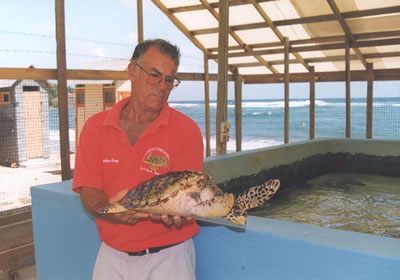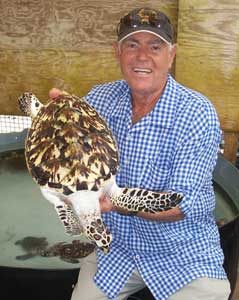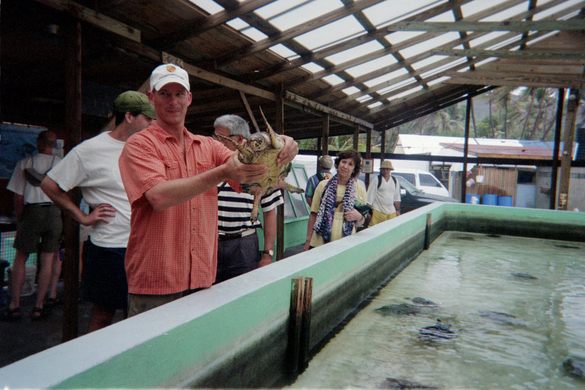Sea Turtle Hatchery
Turtle sanctuary with a fascinating backstory that may be more troublesome than it appears.
Having founded the Sea Turtle Hatchery in 1995, Orton “Brother” King has dedicated his life to safely releasing Hawksbill turtle hatchlings into the nearby waters.
Raising the turtles from eggs deposited on nearby beaches, Brother King’s goal is to increase the survival rate of these beautiful and fascinating creatures by feeding and protecting them through their most vulnerable time. His special attention to these animals has also lead to a local appreciation for the tenuous situation these animals face. The turtles are no longer hunted locally as in some parts of the world but are valued for their beauty, uniqueness and even their contribution to sustainable tourism.
Though the story is best heard from King himself, his reasons for founding the sanctuary are fascinating. In short, King was the only survivor of a schooner shipwreck, and he spent over two days clinging to the wreckage floating towards Martinique. A man saw him on the beach and from afar thought King was a turtle. But when he went to the turtle, he found a half dead King on the beach instead. Upon recovering King swore that during his time in the open ocean turtles had surrounded him, protecting him from sharks.
Orton “Brother” King vowed that day to do everything he could to protect the turtles that saved him, and since then, has very much lived up to that promise.
FIRST PERSON UPDATE (August 2014), by Atlas Obscura user LaTortueNoire
How embarrassing this so-called Turtle “Sanctuary” is. As soon as I knew for sure that I was going to spend some time in Bequia, I was determined to stop by the hatchery (just look at my alias and my profile picture to understand why: I love sea-turtles). My second morning in Bequia, I rushed to the northern end of the island and found the hatchery by the seashore. But I spent only 20 minutes there before fleeing. Because there is something terribly wrong with this place.
I couldn’t get it out of my mind and I started asking questions around Bequia. So here are some facts that everyone can learn from talking to local people and park rangers, and a few other pieces of information from turtle conservation databases. As incredible as this might sound, most of these will be confirmed by the founder and owner of the hatchery himself, Orton King. (At the very end of this list, however, I have included some more information that is more difficult to confirm) Please be objective and come to your own conclusion as to how this place is run.
Facts :
1. First, about the pools and the turtles there :
- The biggest pool is a 6m x 3m tank, 50 cm deep, with 35 cm of sea-water in it. Twenty-five big adult turtles are in there, trying to swim in circles but there is not enough space for them to do so. They try to swim over other turtles, they surface and reach the edge of the tank to breathe and to drag themselves out.
- There is one smaller tank (4m x 2m) for baby turtles. There, two signs warn the visitors “Do Not Touch The Babies, Your Hands Might Make Them Sick”. Yet the employee on duty keeps grasping the baby turtles from the water to hand them to the tourists to hold and take pictures with. The babies are stressed when out of the water.
- There are many other so-called “one turtle” sized tanks, almost twenty in total. Those are square shaped, 60 cm x 60 cm, and in each one there is an adult. These turtles are too big for these small tanks and it is impossible for them to turn around. They remain still, looking at the visitors passing by.
- The hatchery building itself is not in good shape, part of the roof is damaged and rusty, almost falling down.
- Due to the small size of the pools, turtles develop fungus on their shells. Everyone can see it on the turtles, as well as all the brushes that are used to try and remove the fungus from the shells.
- To clean the turtles and the tanks, the staff uses a bleach solution. The bleach bottles are for all to see to one side of the hatchery. (At one time Orton King had so many empty bleach bottles he made a Christmas Tree out of them.)
- The dirty water and the bleach solution are pumped into the sea. On the seashore next to the hatchery (5 meters from the building) there is a huge amount of dead discoloured coral. Everyone can see it. As soon as you walk further along Park Bay from the hatchery, the seashore and coral goes back to the natural colour.
- The mortality rate of the turtles at this hatchery is in excess of 85%. To explain this high figure, Orton King asserts that however large this figure sounds, it is less than the mortality rate of turtles in their natural habitat (around 95%). This is true. However, the average mortality rate in turtle hatcheries around the world is far less than 85%.
- It is not uncommon to see the remains of dead turtles on the discoloured seashore next to the hatchery. The remains were simply thrown over the fence.
2. Then, facts about Orton King (owner and founder of the hatchery):
- Orton King was formerly a well-known turtle-hunter on Bequia. When he understood that he could earn more money by bringing tourist to a hatchery than by hunting turtles, he changed his activity from hunting turtles to keeping them in captivity. As a matter of fact, the whole “survivor of a shipwreck” story is nothing more than marketing.
- Orton King does not own the land on which he has built the hatchery, he is squatting on it. In St-Vincent & the Grenadines (hence in Bequia) there is a law stating that if you squat and live on land long enough (for over 8 years) you can then file a case to own it. Local people informed me that it is an on-going case here.
- Orton King has built more buildings next to the hatchery, including a house and sheds for him to keep his own animals, mainly goats and sheep. While he has recently fenced off the land he is squatting on, many of his animals still roam free and are damaging other people’s property in the area, and impacting on an already delicate environment at the northern end of Bequia (remember this is a very small island).
- Orton King claims that the entrance fee he charges goes back into the conservation of the turtles. Yet the main hatchery building, as previously said, is in very poor condition. The other buildings he has constructed have received much more resources then the structure housing the turtles.
- Orton King is one of the wealthiest local men on the island. He owns and operates the beer importation franchise in Bequia. He owns the big warehouse in Port Elizabeth which is locally nicknamed as “the Brewery” where the beer for all the island is stored.
- The hatchery is now listed on all tourist maps of Bequia. It is pictured on many of the postcards sold here. It appears in most of the tourist guides available for St-Vincent & the Grenadines. It is a gold mine, and a way to attract tourists to that little island.
More “well-known” information which is however more difficult to confirm:
- Orton King does not gather injured or crippled turtles around the island (not even “orphans” babies) to then shelter them before releasing them into the wild : when he or his staff spot a fresh nest on a beach, they empty it. They collect the eggs and bring them to the “sanctuary.” The turtles are born there so tourists can have animals to see. But the eggs taken by Orton King would have hatched naturally after about 60 days under the sand, and the babies would have rushed to the sea by themselves. There is no reason for taking the eggs from their natural habitat.
- Real turtle hatcheries around the world usually keep the turtles for about one year. Orton King is quoted to say that he keeps ‘his’ turtles at the hatchery for often up to two years. Conservationists argue that keeping turtles this long makes them loose their natural instincts and ability to prey… So when the turtles are eventually released, they die of hunger nonetheless. Would the only reason for keeping turtles at the hatchery for two years be to make additional money?
- With many turtles living in a small space, there is over competition for food : they often bite each other. This contributes to the high mortality rate, as infections frequently arise.The “No Touching” sign is not there to protect the babies from the ‘dirty’ hands of the visitors. It is there to protect the visitors from the diseases the turtles get.
- The former Prime Minister of Saint-Vincent and the Grenadines (Sir James Mitchell) refused to interfere or close down the hatchery because Orton King is a local man from Bequia. The current Prime Minister (Ralph Gonsalves) refuses to intervene because Orton King is a member of his own political party.
The daughter of Sir James Mitchell herself, Louise Mitchell-Joseph, who is a passionate conservationist, has often denounced in the press the poor management of the hatchery.
- Many taxi drivers will admit that they are angry and embarrassed at the poor conditions in which the turtles are kept. But they make significant revenue from bringing visitors to the hatchery, so…
- Orton King asks every taxi driver bringing visitors to the hatchery to pay him a commission.
- International turtle conservation organizations have visited the hatchery, and have expressed their horror with how it is run and operated. There is no partnership of any kind between the hatchery and any other organisation around the world.
Finally and in conclusion…
It is true that sea-turtles are now protected almost all over the Caribbean, and are now more numerous than before. To be fair, the hatchery in Bequia might have helped raising awareness of the need for turtle conservation. But turtle hunting is still legal in St-Vincent & the Grenadines, in all waters except the Tobago Cays Marine National Park and during the short closed season. Indeed it is possible after visiting the hatchery to then drive 20 minutes to Paget Farm on the south side of Bequia (near the airport) and see fishermen chop up sea turtles with machete. Turtle soup is a well known local dish.
Louise Mitchell-Joseph (daughter of the former Prime Minister) : “- In St-Vincent & the Grenadines it is legal to kill the critically endangered leatherback and hawksbill turtles most of the year. We have the shortest closed season in the entire Caribbean. Time to change this.”
Without being naïve in any way, the hatchery in Bequia is far from being an animal-friendly zone. And “hatchery”, or even “sanctuary”, are definitely not the proper words to call that place.













Follow us on Twitter to get the latest on the world's hidden wonders.
Like us on Facebook to get the latest on the world's hidden wonders.
Follow us on Twitter Like us on Facebook